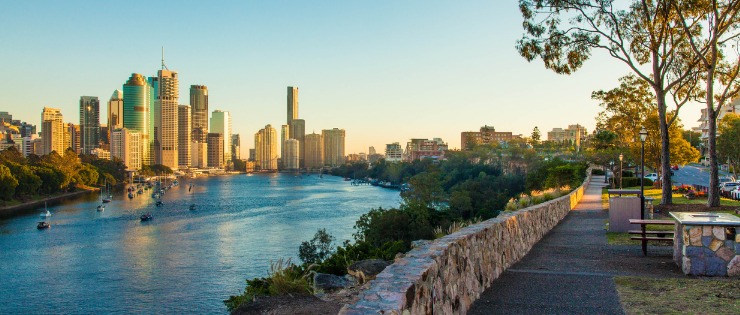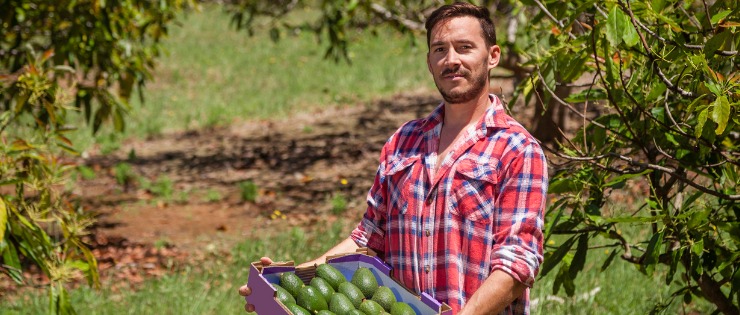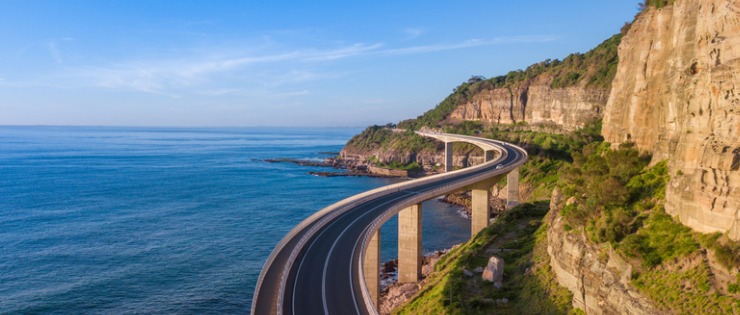
Moving to Australia from Canada is a dream for many Canadians seeking a warmer climate. Sunny beaches and a relaxed lifestyle aren’t the only reasons for moving to Australia though.
The 2016 Expat Insider Survey ranked Australia as the 7th best expat destination in the world. Australia ranks highly for quality of life, work life balance, family life and leisure options which is why many Canadians migrate here for work opportunities and working holidays.
1. Which Australian City to Live In?
Australia has seven states and territories, each with a capital city. The four most popular cities migrants choose to settle in are Sydney, Melbourne, Perth and Brisbane. So which one is right for you?
Sydney, New South Wales
Sydney is Australia’s largest capital city. Its iconic landmarks make it famous but if you are not used to traffic jams and a fast pace of life back in Canada, you may want to consider one of the smaller capital cities. Sydney is by far the most expensive to buy or rent. You can research housing prices for all states on realestate.com.au. If you can handle the traffic and housing costs, Sydney has many job opportunities and sights to see.
Melbourne, Victoria
Cosmopolitan Melbourne has plenty to offer. It’s the second largest capital city in Australia with 5 million people and growing quickly - it could overtake Sydney as Australia’s most populated capital city by 2030. The cost of living is less than Sydney because of house prices but still higher than the other capitals.
Victoria’s economy has been booming over the past five years and delivers 24% of the national Gross Domestic Product from a range of industries. Melbourne is listed as the second most liveable city in 2018 (behind Vienna) with an impressive score of 98.4 out of 100 on the Economist’s 2018 Global Liveability Index. In 2017 Melbourne had held the top spot for seven years in a row. Melbourne is one of the coldest Australian capital cities in winter although nothing like a Canadian winter!
Perth, Western Australia
With a temperate Mediterranean climate and pristine beaches, Perth is a popular choice for Canadians looking for an active, outdoor lifestyle. Perth has a large expat community (over 35% of residents were born overseas) making it easy for new Canadian migrants to fit in. While it’s the largest state in Australia in terms of land mass, it has a small population of 2.5 million. Workers with experience in the mining industry have excellent prospects for work in the northern part of Western Australia. Fly-in, fly-out jobs from Perth are more common than living in the harsh conditions of the northern WA.
Brisbane, Queensland
Sunny Brisbane is popular with locals and migrants alike. Interstate migration of 24,000 increased the population to 4.9 million in 2018. Queensland’s housing affordability and standard of living are big drivers of population growth. Like WA, regional areas of Queensland have mining as their main industry. QLD is famous for its warm climate and beaches hence its nickname “The Sunshine State”.
If you want to get away from busy city living, there are thousands of regional towns and cities to choose from. Australia is a massive country so do your research and find your ideal location. It’s easier to get a visa for some occupations if you want to live in a regional area because there are shortages of some skilled professionals in rural regions.

2. Australian Visas
There are several different visas for people wanting to move to Australia. The Australian Government’s Department of Home Affairs handles visa applications.
Do I Qualify to Immigrate to Australia?
Canadians wanting to immigrate to Australia have several different visa options. Immigration is based on qualifications, work experience and skills for skilled professionals and tradespeople wanting to work in Australia.
A migration agent can help with advice on the most appropriate visa to apply for, preparing documentation, and submitting applications. While using an agent won’t improve your application’s chance of success, it may help reduce your workload and better understand how the visa system works.
Working Visas
The Employer Nomination Scheme visa is for skilled workers nominated by an Australian employer to live and work here permanently. If you are being nominated, your occupation must be on the eligible skilled occupations list. You and your family must also meet the health and character requirements.
The Skilled Independent Visa allows for workers under the age of 45 with skills Australia needs to live and work anywhere in Australia. Applicants must be invited but don’t need a sponsor or nominator. Check out the comprehensive list of occupations eligible for Australian immigration and visas for 2019.
Can you Immigrate to Australia over 50?
You can’t migrate to Australia under the Skilled Migration categories if you are over the age of 50. There are other immigration options such as Employment Based where you find a job in Australia and the employer confirms there is a skills shortage for that role or Starting a Business if you have the necessary business or management experience. For a permanent visa under the Employer Nomination Scheme you must be under the age of 45 at the time of application.
How Long can a Canadian Citizen Stay in Australia?
The length of stay depends on the type of visa you have. Short stay tourist or business visas allow you to travel and stay in Australia for up to three months. Long-stay visitor visas are valid for up to 12 months. Working holiday visas are for 12 months but can be extended for a further year. Skilled migration visas are valid for up to 5 years and can be reissued for another 5 years if you lived in Australia for at least two of those years.
Partner and Family Visas
There are several visas for family members of people with working visas. The Partner Visa allows for de facto partners or spouses of citizens to gain a temporary and permanent visa to stay in Australia. The Dependent Child Visa is for dependent children of a visa-holding parent and must be sponsored by the parent’s nominator or sponsor.
A Contributory Aged Parent Visa or Parent Visa is a permanent visa for the parents of settled migrants who are either citizens or permanent residents.
Work and Holiday Visas
If you are aged between 18 and 30 years, you can apply for an extended holiday in Australia and work while you are here. The First Work and Holiday Visa allows you to stay in Australia for 12 months and if you complete at least three months of work in a specific industry in northern or regional Australia, you can apply for a Second Work and Holiday Visa to give you another 12 months. Find out more about working holiday visas here.

3. Finding Work
Once you have sorted out your visa application, you now need to find a job.
Permanent Work
The type of work you are looking will play a big factor in your job hunt success. Some fields and areas have a shortage of skilled workers and if you have experience or qualifications in that field, you will find work easy. If your industry isn’t in high demand, you may need to consider working in a different field for a while. You can always keep looking for your ideal job once you have secured another job.
The Home Affairs department publishes a skilled occupation list with a list of current skilled occupations that are in demand so many be eligible for various visas. There are many professions listed so take a look to see if your job is listed and then see what visa options are available. This list is reviewed and changed regularly as demand changes.
Job Websites
There are plenty of job sites you can use to search for jobs in different locations in Australia. Most job sites allow you to search by industry type and location.
Some of the most popular career sites are:
Recruitment Consultants
You can also contact recruitment consultants and place your CV with them. They may ask you to come in for an interview to discuss your prospects or you could request a telephone call if you haven’t arrived in Australia yet. Some agencies specialise in industries so look for agencies that advertise jobs in your field.
Casual Holiday Work
Australia is an expensive country to travel in, especially if you want to see every state and territory. Whether you drive or fly, it isn’t cheap and if you don’t arrive with significant savings you will need to work. A working holiday visa only allows you to work for one employer for a maximum of six months then you must move on.
Backpacker Jobs
Australia is a popular country for young Canadians wanting to enjoy a gap year. A working holiday is the only way most travellers can afford to travel around Australia for 12 months or more.
If you are looking to enjoy a working holiday in Australia, check out your work options on the SWAP Working Holidays website. Workers are in high demand in some fruit picking regions of Australia. The Harvest website advertises job vacancies.You will meet plenty of other young travellers from around the world. People wanting to extend their working holiday visa past 12 months need to work in a regional area.
If you want to work in a venue that sells alcohol, you might find work more easily if you complete RSA (Responsible Service of Alcohol) training.

4. Paying Tax in Australia
To work in Australia, foreign residents need a work visa and Tax File Number (TFN). Once you earn more than $18,200 in a financial year, the federal government requires you to pay tax and file a tax return with the Australian Taxation Office. The financial year runs between 1 July and 30 June.
Income Tax Rates in Australia
The amount of tax you pay depends on how much income you earn. Australian residents and Australian tax non-residents have different tax rates.
Tax Rates - Residents
The individual income tax rates for 2019 are:
Income Tax Rate Tax
$0 - $18,200 0% Nil
$18,201 - $37,000 19% 19c for each $1 over $18,200
$37,001 - $90,000 32.5% $3,572 plus 32.5c for each $1 over $37,000
$90,001 - $180,000 37% $20,797 plus 37c for each $1 over $90,000
$180,001 and over 45% $54,097 plus 45c for each $1 over $180,000
Tax Rates - Non-Residents
Australian tax non-resident (foreign resident) for 2019 are:
Income Tax Rate Tax
$0 - $90,000 32.5% 32.5c for each $1
$90,001 – $180,000 37% $29,250 plus 37c for each $1 over $90,000
$180,001 and over 45% $62,550 plus 45c for each $1 over $180,000
Temporary residents usually pay tax only on the income they earn from Australian-sourced income. So, as a Canadian, if you leave income-producing assets like shares or real estate in Canada, Australia may not require you to pay tax on the income.
You can better understand your tax requirements by working out if you are an Australian or foreign resident for tax purposes. It’s sometimes complicated because the ATO and Department of Home Affairs use different rules. The Canadian Revenue Agency website can help you determine if you are a resident or non-resident for tax purposes.
5. Superannuation for Foreign Residents
In Australia workers earn superannuation from their employer which is paid into a fund that they can only access after retirement age. This is intended to help people save better for retirement. A minimum 9.5% of pre-tax earnings are paid into a nominated superannuation fund for employees over the age of 18 who earn more than $450 a month.
Migrants Access to Superannuation
Superannuation is paid to residents and non-residents for tax purposes, permanent and casual workers. The ATO deducts 15% tax from the contribution. The funds are held in your superannuation fund which can’t be accessed until retirement age. However, if you leave Australia permanently to return to Canada, you can apply for a withdrawal. The Australian Government taxes withdrawal of the funds at a rate of 35%.
6. Health Insurance and Medicare in Australia
Whenever you leave your home country, you need to consider the cost of medical treatment where you are travelling. Australia has an excellent health system, including a public healthcare system that subsidises many medical costs for Australian residents and residents of countries that have a reciprocal agreement with Australia.
Health Insurance Visa Requirements
If you are visiting or migrating to Australia, you may need to organise health insurance as it’s a requirement of some visas. Without health insurance or travel insurance, if you have an accident or fall ill in Australia, you may not be covered for most of the medical expenses. A short stay in hospital could cost you tens of thousands of dollars.
Australia has a Reciprocal Health Care Agreement with several countries. The agreement covers overseas visitors for medically necessary treatment while they travel within Australia. Unfortunately for Canadians wanting to live in Australia there isn’t an agreement between the governments of Australia and Canada. This means Canadians need to get appropriate travel insurance or overseas visitors health cover to make sure they are insured in case of a medical emergency.
The Department of Immigration and Border Protection (DIBP) may require a letter of compliance from a health insurer to prove you hold the right level of health cover. Different policies are available for working and non-working visa holders.
Government-Funded Health Care
Australia has one of the best healthcare systems in the world.
Medicare is the Australian health care scheme funded by taxpayers contributing a Medicare Levy of 2% of their income. Medicare provides free public hospital care, free or rebated visits to the doctor and a subsidy of essential medications.
While Medicare is available for Australian residents and citizens, many people choose to take out a health insurance policy to avoid long hospital waiting lists and enjoy a range of benefits not available through Medicare.
Getting a Medicare Card
To be eligible for a Medicare card you must live in Australia and be:
Pharmaceutical Benefits Scheme (PBS)
The PBS includes a wide range of medicines subsidised by the Australian Government. Australian residents can access the PBS with a current Medicare card and overseas visitors from countries with a RHCA.
7. Cost of Living in Australia
When deciding to move to another country the cost of living is important to consider. You could be happy to sacrifice income or be willing to pay more in daily expenses in exchange for a better lifestyle but you should be well informed about all financial implications before you decide to make the move.
Is Australia Expensive to Live In for Canadians?
Australia has a high cost of living compared to most countries in the world. Cost of living takes into account restaurant meals, fruit, vegetables, meat and bread, public transport, utilities, child care, clothing, playing sporting and leisure activities. They also use the cost of buying and renting an apartment and the average to do the calculations on the Numbeo website. As you can see the cost of living in Australia varies depending on the city. Sydney and Perth have high cost of living indexes while Adelaide is the most affordable capital city,
For Canadians, on average it’s actually cheaper to live in Australia! The cost of living in Australia is 10.44% lower than Canada (with rent not taken into account). The average rent in Canada is 18.75% lower than in Australia.
To compare, Australia’s cost of living is 4.66% higher than in the United States (with rent not taken into account) but rent is 10.25% lower in Australia than the US. The data is an average of all cities.

8. Transferring Money
One of the first things to do when moving to a new country is to set up a bank account. To stop fraud the Australian Government requires banks use a 100 point system to identify you when opening any bank account. You can view the types of documentation you can use as identification.
Types of Identification
When you first arrive in Australia, you will only have a few forms of identification that can help open a bank account. The following are documents that recent arrivals are most likely to have.
Primary documentation (each one is 70 points)
Secondary documentation (each one is 35 points)
Secondary documentation (each one is 25 points)
Foreign drivers licence
Marriage certificate
EFTPOS card
If you work in Australia, your employer needs your bank account details to pay you. Typically salaries are paid straight into the employee’s bank account weekly, bi-weekly or monthly. If you want to move Canadian dollars to Australia, you will need to do your research especially if it’s a large amount. There are fees, costs and varying exchange rates to consider. Talk to your bank for advice and research your options online to make sure you don’t pay more than you need to in fees and exchange rates.
9. Educating Your Kids in Australia
Australia has a high-quality education system. Primary school is pre-primary to Year 6 and high school is for Years 7 to 12.
School-aged children can attend a state-funded primary and high school or a private school. The school fees are minimal at a public school for locals but the parents of newly arrived migrant children may be subject to fees by the state government. Check with the Department of Education for the state you are considering so there are no surprises.
Most public schools have boundaries so unless you buy or rent a home in the school’s catchment area, your child cannot attend. If you are living within the boundary, the public school will offer your child a place.
All capital cities have private schools that will take children living in any area if there is a vacancy. Some private schools have wait lists of students wanting to attend.
Education is managed by each state and territory in Australia so it differs slightly across the country. In the past 10 years there have been steps made to make education more uniform with the Australian Curriculum. All school children sit the NAPLAN test in Years 3,5,7 and 9. The national assessment program test students in reading, writing, spelling, grammar, punctuation, and numeracy.
10. Transport – Getting Around
Australia is a car-loving country. It’s a big country and the capital cities are far apart so expect long drives and lots of travel time if you want to move around.
Most of the capital cities are sprawling and spread out so many families own two cars to travel around the sprawling suburbs. Most capital cities have an efficient, cost-effective public transport system made up of buses, trains, light rail and ferries. Melbourne’s CBD and inner city suburbs uses a tram network. The capital cities have reusable smart cards so there is no need to find the correct change. You card works for most modes of transport in the state but each state has their own smart card. If you live close to the city you may be able to use public transport for most travel but if you are in the suburbs you will most likely need to buy a car.
You can save a lot of money by using public transport. If you plan to use public transport to get to work or school, check the options and travel time before agreeing to buy or rent a house.

11. Moving Your Belongings & Pets
Moving to Australia from almost anywhere in the world is a big move and Canada is one of the furthest locations from Australia! While it’s easy to buy a plane ticket to get yourself over here, it’s a different story for transferring your worldly possessions.
Residential movers can pack and ship your goods to Australia. It’s expensive to ship an entire household, so get multiple quotes and try to make sure you can compare quotes by shipping on the same day etc. Look for any hidden fees, excludes and ask plenty of questions.
Ideally, ask for recommendations for international moving companies from other people who have migrated overseas. Your goods will need to be inspected and cleared by Customs on arrival in Australia. Be careful not to pack alcohol (opened or sealed) or cigarettes as they attract duty. Personal and household effects are exempt from duty as long as they have been used for 12 months before departure.
Australia has strict firearm and dangerous weapon laws prohibiting them from being brought in to the country. Australia also has some of the strictest quarantine laws in the world so any food, plant material and animal products must be declared and inspected. There are also restrictions on moving fruit, vegetables, plants, soil and animals between states and territories in Australia to protect the country’s agricultural industries.
Pets are subject to quarantine laws and have to spend 190 days in quarantine. They can spend most of this time in the country of origin but pets need to spend at least 10 days in a government-approved quarantine facility in Australia before being released to you. It allows only pet cats and dogs migrate. Pet insurance is available in Australia to cover the high cost of unexpected vet bills.
More Information
If you are looking for competitive Visa-Compliant Overseas Visitor Health Cover, you can get an online quote or call one of our friendly staff on 1300 134 060 to answer any queries.